Genderkid, Andrea J., Laura S., and Jessica C. all sent in links to the Fallen Princesses photographs. About her project, photographer Dina Goldstein writes:
These works place Fairy Tale characters in modern day scenarios. In all of the images the Princess is placed in an environment that articulates her conflict. The ‘…happily ever after’ is replaced with a realistic outcome and addresses current issues… Disney’s perfect Princesses [are] juxtaposed with real issues that were affecting women around me, such as illness, addiction and self-image issues.
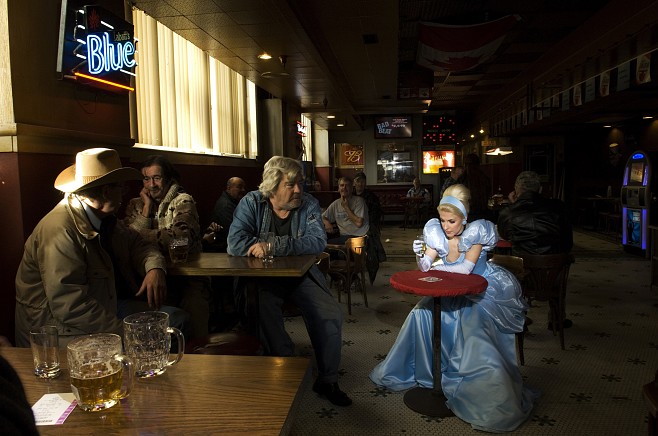
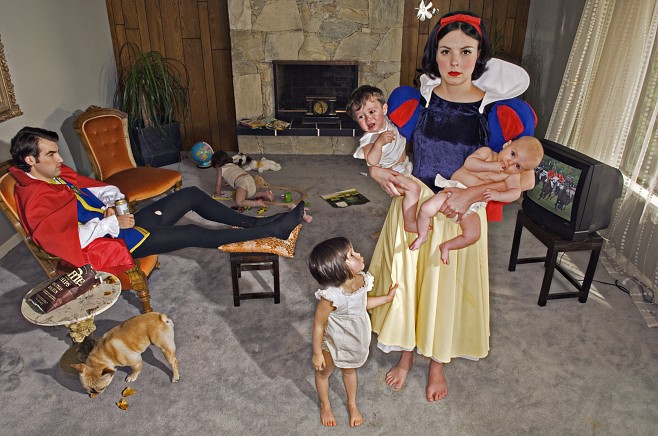
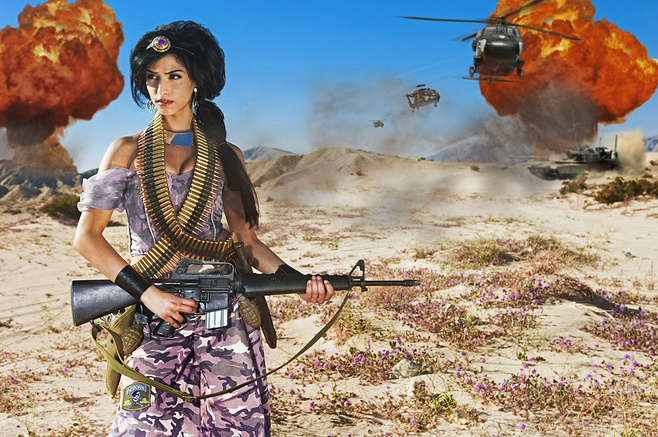
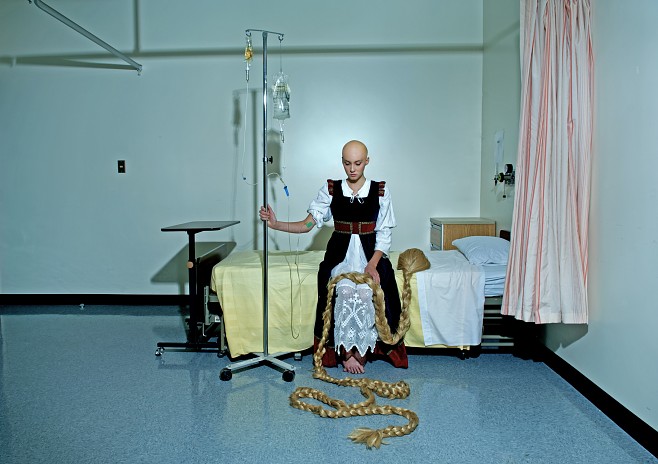
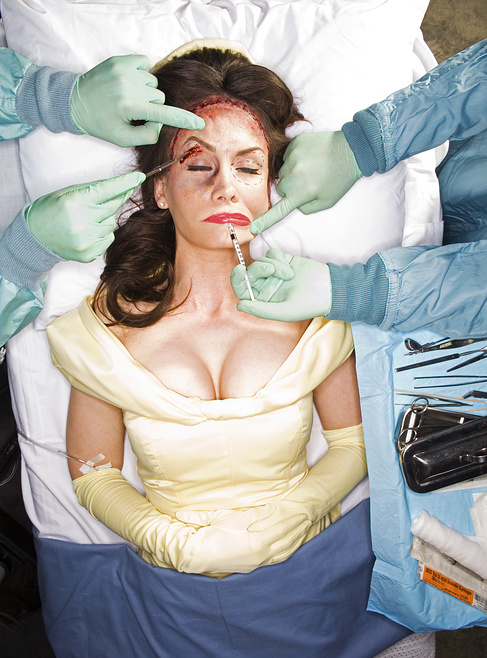
You may want to check out a discussion on Racialicious about presenting Jasmine in a war zone and Women’s Glib‘s discussion of the representation of fatness as “fallen” (and the stereotype that fat people gorg on fast food).
—————————
Lisa Wade is a professor of sociology at Occidental College. You can follow her on Twitter and Facebook.

Comments 56
rachel — July 6, 2009
nevermind that having CANCER makes you a fallen princess. Or strolling into a bar to hang out with friends and have a drink. WTFF????
rachel — July 6, 2009
you know...or having kids. or even having cosmetic surgery. you know, i always thought NOT having cosmetic surgery made you a "fallen" princess. (pun intended)
all these really suck, actually...
Tiffany — July 6, 2009
I love the Jasmine image.
Kontra — July 6, 2009
Rachel's not too bright. Keep up the good work.
Trabb's Boy — July 6, 2009
I don't get it. Is she really claiming that the modern images are "realistic"? Girls dream of growing up into A but really wind up as B? Or is it just old stereotype of women versus new stereotypes of women? And Little Red Riding Hood? What does she have to do with princesses or stereotypes of anything? And yes, that and the Jasmine one are both offensive. The photography is eh, and I can't find a coherent, discernable theme. Just because it's "art" doesn't make it brilliant.
Jennifer — July 6, 2009
I like them; I think they're thought provoking. They may be offensive, they may be unrealistic/stereotypical, but I find them intriguing nevertheless. In that sense, I think the artist succeeded.
Elbu — July 6, 2009
Excuse me - where's the fat person supposed to be? I fail to see a fat princess in these pictures...
abby — July 6, 2009
I agree with Jennifer. They are very interesting. They are about the feelings of growing up, encountering the real world, and longing for your childhood predictions and simple values.
I think the interesting thing about the Belle/plastic surgery photo is that her whole story was (supposedly) about seeing a person's inner beauty – that the outside of a person doesn't matter. However, in the face of aging, she’s changed her mind. I don’t think the artist’s purpose was to make a statement about female stereotypes (which the picture ends up doing anyway), but a statement about childhood idealism and the way we lose it as we mature.
The Cinderella shot is definitely not portraying having a drink with friends. I see it as portraying alcoholism and/or the uncomfortable stares women get when they are alone in a bar full of men. Not everyone is Prince Charming. And then we see from Snow White's family that even Prince Charming is not what you thought he would be.
I find the Little Red Riding Hood photo offensive, and I think the whole series could have done without it. As for Jasmine’s, the artist could have been more creative than simply categorizing her by her ethnicity/religion.
Lance — July 6, 2009
This really was a great concept that failed in execution. Some of them involve "after the happily ever after" images, like Rapunzel losing her hair (her defining quality), or Prince Charming not being so charming.
But Red Riding Hood getting fat, in addition to the other problems with it, doesn't follow in any way at all from her story; neither does Jasmine fighting in a war zone. And as someone pointed out in a comment elsewhere (I forget where, apologies), Belle is the Disney Princess(tm) who's the least likely to be concerned with her looks.
As I said, a fine idea that just didn't come together in execution.
rachel — July 6, 2009
Rapunzel with cancer one especially upset me. As I got to really looking at the others, none were able to really show a "fallen" woman, aside from perhaps the Jasmine one, which is absolutely racist. The only Middle Eastern princess ends up with a gun. Why not any of the white princesses? And just how do we know that Jasmine hasn't taken up the firearm in order to defend herself, anyway? Suppose she is automatically the bad guy because she's brown? I really can't see the merit in this photography project, and if someone wants to declare that that makes me not so bright, well...then that says more about you than it does me...keep up the good work...
Samantha C — July 6, 2009
To me, these images just depress me-- the idea that we can't let a fairy tale be someting inspiring and uplifting and feel-good. That somehow these stories can't have any merit unless reality intrudes on them. I don't understand why the ideal of a Prince Charming is a bad thing that people feel the need to tear down.
to me, fairy tales exist to be ideals and fantasies. I find it depressing that this society is so cynical that we don't see the value in a pure fantasy, in the ideal of Happy Ever After. No, it's not realistic. Yes, relationships take work and magic isn't real. But is it so bad to have a dream? Is it so bad to have an escape, a world where it IS that easy, just to renew our hope? And if we believe that Happy Ever After IS possible after all, aren't we more likely to work toward it in real life? If we believe that, as in these pictures, Prince Charming is going to turn out to be a deadbeat, where's the motivation to work on the relationship?
Elena — July 6, 2009
The only Middle Eastern princess ends up with a gun. Why not any of the white princesses?
TBH, Little Red Riding Hood in a firing range or behind the counter of a gun shop would make more sense than the lolfat picture.
Louisa — July 6, 2009
I saw these posted on ONTD and the majority of the comments were about how poorly done these were. I suppose they could have made some good photos in there somewhere, if it weren't so badly thought out and shoddily put together. It's like they ran to the Disney store and got a bunch of costumes and tried to be edgy.
Miriam Heddy — July 6, 2009
Samantha C...
The notion of fairy tales as being about optimism and hope is, in many ways, a product of Walt Disney more than it is a description of any of these fairy tales in their original forms or anything that the Brothers Grimm or Hans Christian Anderson would recognize.
Aside from the racism and fatphobia in Goldstein's work, the larger problem is that she seems to be considering the "fallen" state of the characters without ever having considered the ways in which the tales themselves (in Grimm's version, for example) define the price of failure.
The originary tales are gruesome things, full of women who cut off their own toes and mermaids who, when they trade up fins for legs, experience walking on those legs as feeling like walking on knives.
For the most part, fairy tales before Disney functioned not as promises of dreamy happily ever afters but as cautionary tales about the *dangers* of things like escapism, dreams, and fantasies. They were in many ways deeply conservative, designed to reconcile children (particularly girl children) to a lifetime of ordinary living, safe domesticity, and other not-so-exciting things. Their message was often to be satisfied with what you have, to be wary of strange men, etc.
Fun, huh?
Miranda — July 6, 2009
Elbu: "Excuse me - where’s the fat person supposed to be? I fail to see a fat princess in these pictures…"
Yeah, the Little Red Riding Hood fat-shaming picture isn't included in this post. But it's in my post on Women's Glib, that's linked above.
trannypunk — July 6, 2009
I think these pictures are great.
'fallen' is obviously being loosely used; these are DISNEY characters, which might as well be biblical; at least in regards to their purity etc. They are in 'real' situations. Cancer is real. The bar full of yokels is real. They have fallen from Disney nonreality into the real world.
This is almost a commentary on what happens to children, especially little wymmyn who are raised on the disney fairy tale; then grow up to discover a harsh and unjust world.
Samantha C — July 6, 2009
Miriam-- I definitely knew that the original fairy tales were much less optimistic than the disney. But there's absolutely no doubt that these pictures are using the cartoons, so I feel my comment is still justified ;) I think the fact remains that a large part of this society is cynical about dreams and escapism, and I find that both sad and interesting. I didn't read the series as much as a comment about the "non-reality" of the Disney fairy-tale world, but more as a reflection on a society that can't see a happy ending. It's not what really happens, therefore it has no value. I'm a hopeless romantic, and I see a lot of value in teaching children that they can hope, that happiness comes to good people, that true love exists. Of course it's not as simple as all that, but I find it so odd to see people claiming that these are bad things to teach, because kids will eventually grow up and grow out of them
all I can say is i'm 20, and I certainly haven't given up on finding a prince ;) yes, the real world is messy and dirty and has unhappiness and cancer and alchoholism. But it also DOES have happy marriages and triumphs over adversity, and I just think it's a neat sociological discussion about why this artist felt the need to take these fairy-tale figures out of their realities and put them in our own.
Miriam Heddy — July 6, 2009
Sarah C writes, "all I can say is i’m 20, and I certainly haven’t given up on finding a prince ;) yes, the real world is messy and dirty and has unhappiness and cancer and alchoholism. But it also DOES have happy marriages and triumphs over adversity, and I just think it’s a neat sociological discussion about why this artist felt the need to take these fairy-tale figures out of their realities and put them in our own."
Well, I come at this from two angles. One is as an academic, which means I'm interested in the ways that Goldstein situates the photos within the context of fairy tales. Yes, the costuming does suggest that she's beginning in the Disney cartoons, but I think that doesn't preclude looking at the origins of those cartoons, and I think that the flatness of her interpretation is owing, at least in part, to her not seeming to have a sense of the many layers (and what she does with Jasmine, in particular, suggests she hasn't thought much about Disney's own racist history).
With regards to putting them in our own reality, I'd argue they already *are* in our reality. As a mom with a 5 year old who, despite all my wishes otherwise, aspires to be a princess (among other things) and who has asked me, "Why aren't there any fat princesses in Disney movies?" I can only say that the real world is messy indeed, and I'm not convinced that happiness can be achieved without even our 5 year olds coming to grapple with that mess.
Samantha C — July 6, 2009
I think half of the fun of a Disney Princess is that they exist in an idealized world. That's what I mean by "their reality"; Belle is never going to grow old and have the vaguest desire to change the way she looks, because she lives in a movie that ends with her marriage. What's interesting to me is the very fact that people feel a need to 'correct' that by projects like this. The real world contains this ideal as a fantasy, but not as a reality.
Honestly, what bugs me the most about the photos is that it's not an incredibly insightful thought to say "ha ha, fairy tales don't work like real life". Of course they don't. That's why we enjoy them.
Natalie — July 7, 2009
I agree with trannypunk's reading of "fallen". Certainly Rapunzel isn't portrayed as having done anything wrong, but something has been done to her.
Jasmine is interesting, though, in that she is not portrayed regretful or in pain - the shot of her could easily be the cover of a video game where she plays a happily "kick ass" character. She even seems to have the beginnings of the enhanced cleavage of a Lara Croft-esque game character.
Loony toons — July 7, 2009
They were primarily made to be shocking, so who ever set this up attempted to make something they knew would hit a nerve with some people. Its mostly shock value, and this is coming from someone who likes to parody things and mock whatever she can.
The person who originally made this is just poking fun at everything and didn't really attempt to put effort into themeing her photos to ACTUALLY go along with the origins of the characters. She wanted to take her shot at the characters, she did and now is hoping it says something 'edgy' about them. Cause taking pot shots at Disney cartoons is apparently cutting edge these days.
Ether way, the photo's are intriguing, but lazy about what was done to the princesses.
Not quite what Walt had imagined « Library Voice — July 7, 2009
[...] Dina Goldstein’s photograh series, Fallen Princesses, isn’t quite what I had in mind, it’s certainly thought-provoking and funny (in a sad, [...]
Melissa Jones — July 9, 2009
II think that just the process of creating these images has made them successful. As a visual artist myself i can appreciate the effort that went in and the striking outcomes.
just the fact that these photos have brought about all this healthy debate/discussion/analyzing is a great thing.
i'm sure the photographer is UN apologetic that she couldn't meet the demands of the perfect social statement for all of her critics.
for all of the haters .i'd like to see someone do better.
Zack — July 9, 2009
Samantha C: "Belle is never going to grow old and have the vaguest desire to change the way she looks, because she lives in a movie that ends with her marriage. What’s interesting to me is the very fact that people feel a need to ‘correct’ that by projects like this. The real world contains this ideal as a fantasy, but not as a reality."
Wasn't the "Beast" in Beauty and the Beast actually abusive, domineering and holding her as prisoner? And then the lesson was that "stick to a bad tempered man, treat him nice and he'll soften up"?
It reminds me of a Korean tale about a woman who has a "bad tempered" husband and goes to a wise man to help her. The wise man tells her to bring him the whisker of a tiger. Long story short, she gets the whisker by leaving it a bowl of rice everyday and coaxing it, but the wise man throws it in the fire, because apparently, the woman "found her answer": To be "nice" to her a-- of a husband and that he will treat her nice.
"Stick with your abusive man and don't worry about your new husband." seems to be widespread in many cultures. Personally, I like the story "The Robber Bridegroom" a lot better - it warns about how "giving away" your daughters for marriage (long ago) could go sour.
I wouldn't consider Beauty and the Beast to be "the ideal romance".
Zack — July 9, 2009
This might also be better for two of the pictures:
Cinderella:
-Taking on the Snow White picture's role and cleaning up after Prince Charming - he treats her no better than her sisters and stepmom did.
Belle:
-Sporting a black eye and in chains with the "Beast" in the background.
I think for those two, that would be more accurate. Don't know for the others, though. If something else is better, I'd be interested in hearing it, although the creator of the project should hear it instead.
Andrew — July 10, 2009
Any soil on the gowns of Disney Princesses is fine with me. This seems like a direct reaction to the way Disney's branding has in recent years isolated the princesses from all of its narratives and repackaged them as interchangeable icons, permanently strapped into the dresses they wore for their happy endings. In doing so, they changed the fantasy from a cute, silly retrograde one of overcoming adversity with infallible virtue to find one's prince to a creepy one of simply fluttering around in a dress and being rich and pretty.
With that in mind, I think the face-lift photo is brilliant. What better way to show the consequences of selling beauty as a virtue?
kelly — July 11, 2009
Perhaps the fallen could refer to the way these characters have now fallen in the eyes of a lot of people. I don't see anything offensive here because I don't think the situations these woman are now in make them any less worthy of regard.
Marky — October 27, 2009
This is great. Many women have a 'Cinderella Complex' where they think some knight in shining armor on a white horse is going to show up and they'll live happily ever after. It's about as realistic as a romantic comedy. I really like the Snow White image of barefoot and pregnant. Prince Charming just watches TV. Welcome to the real world ladies.
Disney Princesses, Deconstructed » Sociological Images — October 28, 2009
[...] most posts on Disney princesses, look here, here, here, here, and here. Two other great posts include this rejection letter (”we don’t [...]
DanAfleck — October 28, 2009
I originally thought the Cinderella photo was a comment on the impermanence of a fairy-tale marriage. Upon further inspection, I realized that that was because I thought the jukebox behind her was a slot machine, and I jumped from there to the idea of a Vegas wedding.
Upon still further inspection, I like my version better.
8oinks — Blog — Fallen Princesses by Dina Goldstein — January 4, 2010
[...] Dina Goldstein: ‘…happily ever after’ (via) [...]
Travels: The Listel Hotel: Featuring “Fallen Princesses” By Dina Goldstein: Opiate Madness Controlled. « Citizen Of The World Inc. — January 7, 2010
[...] #2 [via Contexts] January 7th, 2010 | Tags: 2010 NYE, Art, Dina Goldstein, Happy New Year 2010, NYE, Photography, [...]
Trinna — March 15, 2010
I believe what the reality is in these pictures is that these women have the choice to have several babies, go to a bar alone, fight in a war, to get treated for cancer, and have cosmetic surgery.
What is the problem here?
Happily Ever After …? « Jeanette's Blog — April 4, 2010
[...] [1] http://thesocietypages.org/socimages/2009/07/06/fallen-princesses/ [...]
jed — May 31, 2010
The cartoons are interesting... But the commentary is even better. Whata revealing dialogue. Thus: success
och… « Kalashnicore — June 7, 2010
[...] Bilderna har hämtats härifrån och härifrån. [...]
Sophie — June 16, 2010
I'm just wondering, how did Rapunzel's story end up with cancer? The others make some sense, like Beauty's plastic surgery, but I don't get the cancer part.
HAPPILY EVER AFTER, MY FAT STINKY ASS. « FARNAMALS @ WORDPRESS — June 23, 2010
[...] HAPPILY EVER AFTER, MY FAT STINKY ASS. Posted in Culture by farnamals on 23/06/2010 Source: Fallen Princesses [...]
Fallen Princesses « A Lack of Colour — August 18, 2010
[...] (via The Society Pages) [...]
eternalcynic — November 14, 2010
Sophie writes, "I'm just wondering how did Rapunzel's story end up with cancer? The others make some sense, like Beauty's plastic surgery, but I don't get the cancer part."
I realize I'm quite late in replying to this thread; however, I interpreted the image of Rapunzel as her being lost without her one crowning quality; her one point of vanity: her hair.
Trinna said, "I believe what the reality is in these pictures is that these women have the choice to have several babies, go to a bar alone, fight in a war, to get treated for cancer, and have cosmetic surgery.
What is the problem here?"
Whilst I've never been one to dictate how works of art must be interpreted, the concept of "choice" was clearly not Goldstein's purpose. The premise -- of the latent messages of fairy tales and reality -- is oppression. For example, I would argue that the focus on beauty both in the original Cinderella AND in modern times (i.e. the pressure to be beautiful, i.e. plastic surgery) is rooted in oppression, not in the "choice" to become beautiful. What about the choice to believe you are naturally beautiful? No such choice exists in our society. I would also argue that, to some extent, choice is but an illusion. After all, how can one truly choose when one has been brainwashed since birth into accepting the norm? Obviously we HAVE to choose, but I would argue that the POWER of FREE choice is greatly diminished, if not nonexistent, in society? If the pressure to "be pretty" didn't exist, then there would be no pressure to make the choice to get plastic surgery.
eternalcynic — November 14, 2010
Nix the question mark punctuating my second-to-last sentence and make it a period. And "messages of fairy tales" should be "messages IN fairy tales". Danke!
Trinna — November 16, 2010
I think choice is alive and well. There are high school girls who are not wearing makeup to school three days a week. It started with a handfull and is growing very rapidly. I see celebrities who are choosing to not get plastic surgery. I chose woodworking as my profession. Most women eventually see through the "brainwashing" commercial ads, and we have the freedom to make a choice to be the person we want to beor be the model in the ad.
I really do not get the opression angle. I don't feel opressed nore does anyone I know. Where do you live? Maybe that has something to do with how you are looking at this.I think if someone lives in, say Hollywood, they may feel that their choices are limited because there is so much pressure to be beautiful, etc. So I think we should take into account our attitudes in respect to our environment.
Exotic = Sex, In Disney Films « The Disney Influence — December 6, 2010
[...] foreign are their darker complexion and their sexualized personas. Disney has built its empire on “Fantasy” and the sexualized exotic characters are an extension of that [...]
Anthony Orenstein — September 21, 2014
This version of the Disney Princess (Jasmine) wielding a machine gun in a desert war scene has the vague appearance of a mascot for the expanding strife in the Middle East. But it goes even further than that: if the "Global War on Terror" is "a war without end" then I could logically conclude that this latest round of jihad-fueled mayhem is truly World War Three, which could also become The Endless World War. This is certainly a grim picture portrayed by an innocent little princess. It makes me wince to think about it.